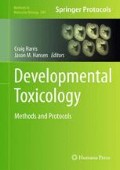Abstract
The founding principles of teratology/developmental toxicology state that a developmental toxicants cause dysmorphogenesis when conceptuses are exposed at a sufficient dosage during a sensitive period of development in a sensitive species. While in vitro approaches in developmental toxicology can provide a means to assess the potency of toxicants, ultimately, the need to use whole animal models to demonstrate embryotoxicity is necessary to fully extrapolate findings to the human condition. This chapter is dedicated to reviewing the advantages of specific animal models and how these animal models may be used to assess toxicity in the embryo, both descriptively and mechanistically.
Access this chapter
Tax calculation will be finalised at checkout
Purchases are for personal use only
References
Wilson JG (1973) Environment and birth defects. Environmental sciences. Academic, New York, NY
National Research Council (U.S.). Committee on Developmental Toxicology., National Research Council (U.S.). Commission on Life Sciences (2000) Scientific frontiers in developmental toxicology and risk assessment. National Academy Press, Washington, DC
Sulston JE (1983) Neuronal cell lineages in the nematode Caenorhabditis elegans. Cold Spring Harb Symp Quant Biol 48(Pt 2):443–452
Sulston JE, Schierenberg E, White JG et al (1983) The embryonic cell lineage of the nematode Caenorhabditis elegans. Dev Biol 100:64–119
Metzstein MM, Stanfield GM, Horvitz HR (1998) Genetics of programmed cell death in C. elegans: past, present and future. Trends Genet 14:410–416
C. elegans Sequence Consortium (1998) Genome sequence of the nematode C. elegans: a platform for investigating biology. Science 282:2012–2018
Mello CC, Kramer JM, Stinchcomb D et al (1991) Efficient gene transfer in C.elegans: extrachromosomal maintenance and integration of transforming sequences. EMBO J 10:3959–3970
Hashmi S, Britton C, Liu J et al (2002) Cathepsin L is essential for embryogenesis and development of Caenorhabditis elegans. J Biol Chem 277:3477–3486
Robertson SM, Shetty P, Lin R (2004) Identification of lineage-specific zygotic transcripts in early Caenorhabditis elegans embryos. Dev Biol 276:493–507
Fire A, Xu S, Montgomery MK et al (1998) Potent and specific genetic interference by double-stranded RNA in Caenorhabditis elegans. Nature 391:806–811
Ellis HM, Horvitz HR (1986) Genetic control of programmed cell death in the nematode C. elegans. Cell 44:817–829
Adams MD, Celniker SE, Holt RA et al (2000) The genome sequence of Drosophila melanogaster. Science 287:2185–2195
Mellerick DM, Liu H (2004) Methanol exposure interferes with morphological cell movements in the Drosophila embryo and causes increased apoptosis in the CNS. J Neurobiol 60:308–318
Geisler R, Rauch GJ, Baier H et al (1999) A radiation hybrid map of the zebrafish genome. Nat Genet 23:86–89
Woods IG, Kelly PD, Chu F et al (2000) A comparative map of the zebrafish genome. Genome Res 10:1903–1914
Ali S, van Mil HG, Richardson MK (2011) Large-scale assessment of the zebrafish embryo as a possible predictive model in toxicity testing. PLoS One 6:e21076
Giles S, Boehm P, Brogan C et al (2008) The effects of ethanol on CNS development in the chick embryo. Reprod Toxicol 25:224–230
Rovasio RA, Battiato NL (1995) Role of early migratory neural crest cells in developmental anomalies induced by ethanol. Int J Dev Biol 39:421–422
Rovasio RA, Battiato NL (2002) Ethanol induces morphological and dynamic changes on in vivo and in vitro neural crest cells. Alcohol Clin Exp Res 26:1286–1298
Johnson CW, Hernandez-Lagunas L, Feng W et al (2011) Vgll2a is required for neural crest cell survival during zebrafish craniofacial development. Dev Biol 357(1):269–281
Waterston RH, Lindblad-Toh K, Birney E et al (2002) Initial sequencing and comparative analysis of the mouse genome. Nature 420:520–562
Fabro S, Smith RL, Williams RT (1965) Thalidomide as a possible biological acylating agent. Nature 208:1208–1209
Schardein JL (2000) Chemically induced birth defects, 3rd edn. Marcel Dekker, New York, NY
Author information
Authors and Affiliations
Corresponding author
Editor information
Editors and Affiliations
Rights and permissions
Copyright information
© 2012 Springer Science+Business Media, LLC
About this protocol
Cite this protocol
Hansen, J.M. (2012). In Vivo Models of Developmental Toxicology. In: Harris, C., Hansen, J. (eds) Developmental Toxicology. Methods in Molecular Biology, vol 889. Humana Press, Totowa, NJ. https://doi.org/10.1007/978-1-61779-867-2_2
Download citation
DOI: https://doi.org/10.1007/978-1-61779-867-2_2
Published:
Publisher Name: Humana Press, Totowa, NJ
Print ISBN: 978-1-61779-866-5
Online ISBN: 978-1-61779-867-2
eBook Packages: Springer Protocols

